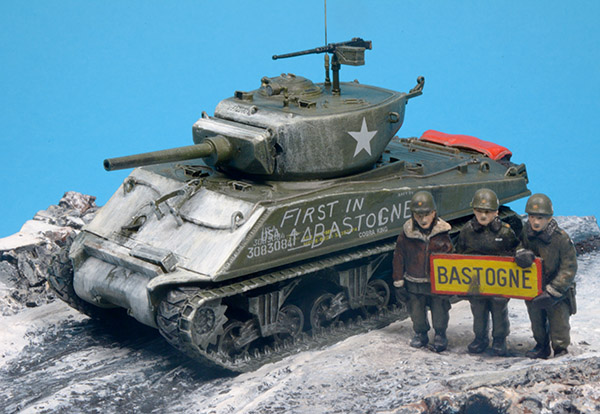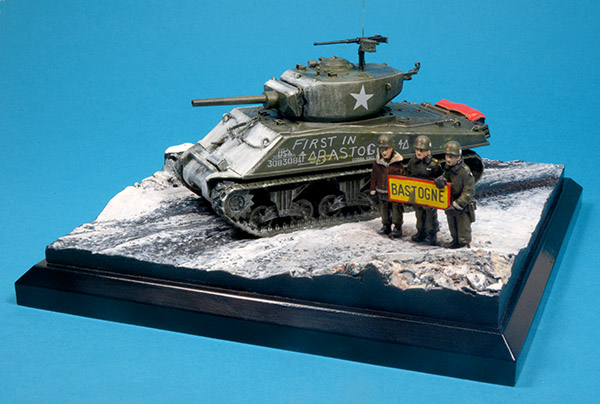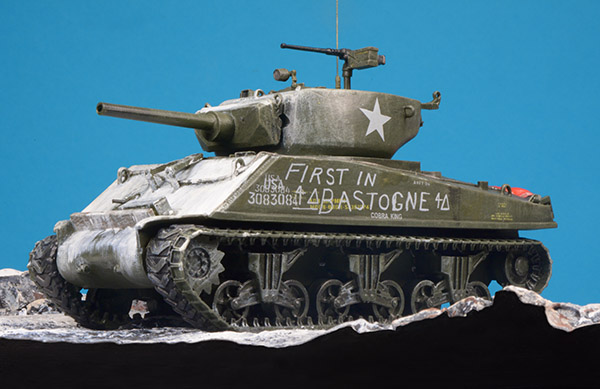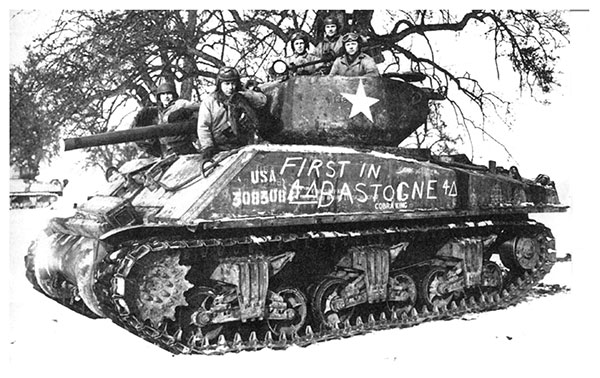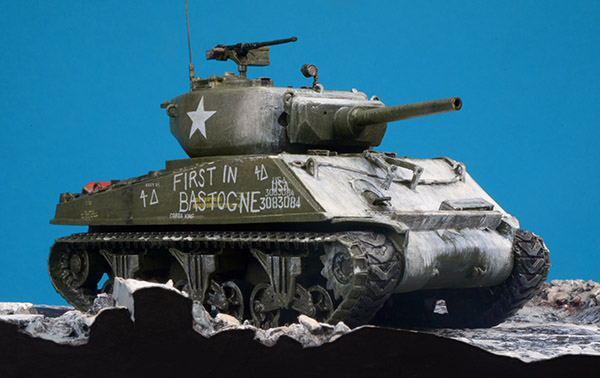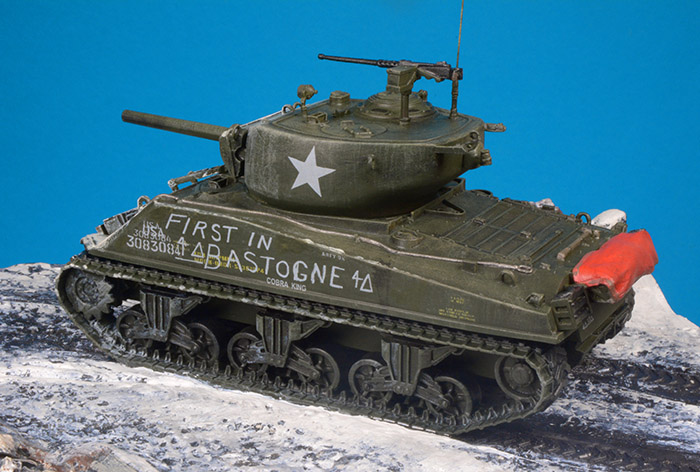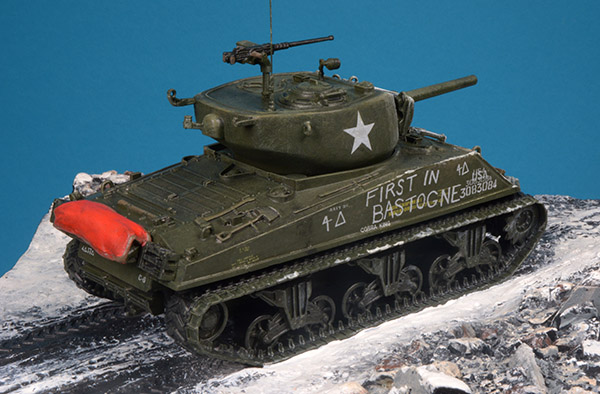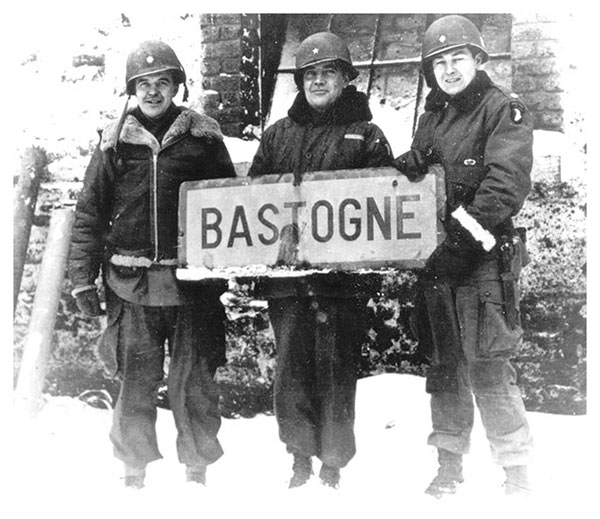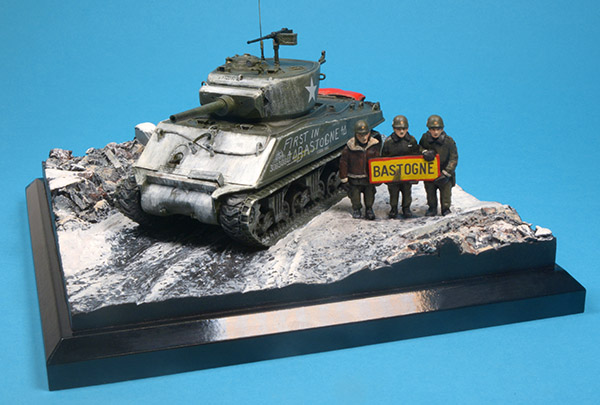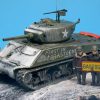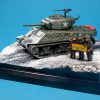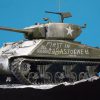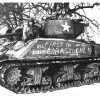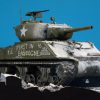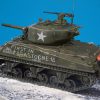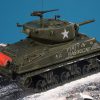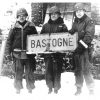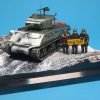M4A3E2 Sherman ‘Cobra King’ / ‘First in Bastogne’
4th Armored Division ‘Battle of the Bulge’
Brigadier General Anthony Clement “Nuts” McAuliffe,
Colonel William L. Roberts
Lieutenant Colonel Creighton Williams Abrams Jr.
Siege of Bastogne, 26th December 1944.
In early 1944, the United States Army decided that they needed an up-armoured version of a medium tank for an assault role for the upcoming operations in the European Theatre of Operations (ETO). The decision was made to modify the standard US Army medium tank of the time, the M4A3 Sherman.
The vehicle became the M4A3E2 Assault tank, later unofficially called ‘Jumbo’. With only 254 built, its iconic profile left a lasting image that is probably one the most easily recognized M4 variants. They were to be available to the army by August 1944. The contract was awarded to the Fisher Body Corporation in Detroit.
The M4A3E2 was to have an additional 1 ½” (38 mm) of armour plate welded to the upper hull front and sides, taking the overall thickness to 4” (101 mm) on the front and 3” (76 mm) on the side. The rear upper hull and top were unchanged, as was the lower hull. Union Steel foundry was subcontracted to cast a heavier final drive assembly cover. The new casting was 3000 lbs (1360 kg) heavier than the standard and had a thickness that varied from 4” (101 mm) to a maximum of 5 ½” (139 mm). The new casting had to have a substantial ridge along the upper edge to allow for the fitting and bolting to the upper hull. The turret had 6″ armoured sides, 2 1/2″ rear and a 7″ mantlet on the front. The 75mm main gun was retained because of its superior high explosive (HE) round.
Because of the increase in weight from 30 to 42 tons, recently developed extended end connectors were fitted to the tracks and helped to reduce the ground pressure even with all the additional weight. They were often called ‘duckbills’.
The first 128 Jumbos arrived in France via Cherbourg on the 22nd September 1944. They were effectively deployed to push back the occupying German forces leading to the ‘Battle of the Bulge’
Taking place from December 16th 1944 to January 25th 1945, the ‘Battle of the Bulge’ was the last major German offensive campaign on the Western Front during World War II. It was launched through the densely forested Ardennes region of Wallonia in eastern Belgium, northeast France, and Luxembourg.
In December 1944 the American 101st Airborne were besieged by German forces at the strategically crucial Belgian town of Bastogne, as part of the larger Battle of the Bulge. The goal of the German offensive was intended to stop Allied use of the Belgian port of Antwerp and to split the Allied lines, allowing the Germans to encircle and destroy four Allied armies and force the Western Allies to negotiate a peace treaty in the Axis powers’ favour. In order to reach it before the Allies could regroup and bring their superior air power to bear, German mechanized forces had to seize the roadways through eastern Belgium. Because all seven main roads in the densely wooded Ardennes highlands converged on Bastogne (Bastnach in German), just a few miles away from the border with neighbouring Luxembourg, control of its crossroads was vital to the German attack.
It was on the 22nd of December that General Von Lüttwitz submitted the following demand for surrender to his American counterpart commanding the American forces in Bastogne, Brigadier General Anthony McAuliffe:
‘To the U.S.A. Commander of the encircled town of Bastogne.’
‘The fortune of war is changing. This time the U.S.A. forces in and near Bastogne have been encircled by strong German armoured units. More German armoured units have crossed the river Our near Ortheuville, have taken Marche and reached St. Hubert by passing through Hompre-Sibret-Tillet. Libramont is in German hands.
There is only one possibility to save the encircled U.S.A. troops from total annihilation: that is the honourable surrender of the encircled town. In order to think it over a term of two hours will be granted beginning with the presentation of this note.
If this proposal should be rejected one German Artillery Corps and six heavy A. A. Battalions are ready to annihilate the U.S.A. troops in and near Bastogne. The order for firing will be given immediately after this two hours term.
All the serious civilian losses caused by this artillery fire would not correspond with the well-known American humanity.’
‘The German Commander.’
Shortly thereafter, McAuliffe, sent the following communication to Von Lüttwitz in response to the German demand
‘To the German Commander.’
‘NUTS!’
‘The American Commander’
Without doubt the most famous of all the Jumbos was named ‘Cobra King’, this was the first tank into Bastogne in Belgium, the vital crossroads town at the centre of the fighting during the Battle of the Bulge. The name ’Cobra King’ is a possible reference to ‘Operation Cobra’, the codename for an offensive launched by the First United States Army, seven weeks after the D-Day landings, during the Normandy Campaign of World War II. The intention was to take advantage of the distraction of the Germans by the British and Canadian attacks around Caen, in ‘Operation Goodwood’ and break through the German defences that were penning in American troops, while the Germans were unbalanced.
‘Cobra King’ was issued to 37th Tank Battalion of the 4th Armoured Division on the 24th or 25th of October 1944 and was assigned as the company commander’s vehicle of Company C.
During the German winter offensive, the Battle of the Bulge, the important crossroads town of Bastogne, Belgium had been cut off and surrounded by German forces. Patton’s Third Army was tasked with trying to break through the German lines in the south with the 4th Armoured Division led by Lieutenant Colonel Creighton Williams Abrams Jr. as the main spearhead of this counterattack.
On December 26, 1944, Lt. Boggess, commander of ‘Cobra King’, was fighting his way on the road from Assenois, Belgium to Bastogne. The following passage is from an article written by Charles Lemons, former curator of the Patton Museum.
‘Cobra King was way ahead of the rest of the column and had just destroyed a German bunker along the road when Boggess spotted several uniformed figures in the woods near the bunker. They wore the uniforms of U.S. soldiers, but knowing how Germans were disguising themselves as Americans, he maintained a wary eye. He shouted to the figures. After no response, he called out again and one man approached the tank. “I’m Lieutenant Webster of the 326th Engineers, 101st Airborne Division. Glad to see you.” With that meeting at 4:50 p.m. on December 26, 1944, Patton’s Third Army had broken through the German lines surrounding Bastogne’
While records of the rest of the crew are not so complete the crew during the Battle of the Bulge is known. First Lieutenant Charles Boggess, Corporal Milton Dickerman, and Privates James G. Murphy, Hubert S. Smith and Harold Hafner.
Famously a photograph was taken of ‘Cobra King’ soon after the relief of Bastogne together with photographs of the commanding officers involved holding the ‘Bastogne’ sign which now resides in the local museum.
The M4A3E2 Sherman‘Cobra King’ was one of the Jumbos to receive a 76 mm gun upgrade and it’s coaxial machine-gun was also upgraded to a .50 cal (12.7 mm) in early 1945.
In March 1945 Sherman ‘Cobra King’ took part in the ill-fated, ‘Operation Hammelburg’
The operation took place on March 26-28, 1945 with the official purpose of liberating a prisoner of war camp, OFLAG XIII-B, near Hammelburg, Germany. But unofficially, it’s purpose was to free Patton’s son-in-law, Lieutenant Colonel John Waters, who was taken prisoner at Kasserine Pass, Tunisia, in 1943.
A small task force comprised of men and vehicles from the 37th Tank Battalion and 10th Armoured Infantry Battalion commanded by Captain Abraham J. Baum, was formed. Task Force Baum consisted of M4A3 Shermans, M5A1 Stuarts, M4/105 Shermans, Jeeps and halftracks. The total strength was 314 men and 57 vehicles.
The task force fought through German lines with serious losses and reached Hammelburg and liberated the camp, but Patton’s son-in-law was wounded and had to be left behind. Ultimately, the entire operation turned into a total failure when German forces in the area eventually overwhelmed the small task force, destroying or capturing all vehicles and capturing Baum and almost all of his men and the liberated POWs.
It is believed that the Germans attempted to destroy ‘Cobra King’ by torching her as the 14th Armoured Division approached Hammelburg in April 1945 to prevent it falling back into US hands in an operational condition.
After the war, the M4A3E2 Sherman ‘Cobra King’ became a monument tank, put on display at Erlangen, Germany and then from there relocated to Vilseck, Germany where it remained in obscurity, In May 2001, Army Chaplain Keith Goode was checking out monument tanks while serving in Germany. He was locating serial and registration numbers of Sherman tanks on U.S. Army bases. He passed on information to the G104 Sherman interest group in the U.S. where it was confirmed that the tank was indeed the actual ‘Cobra King’ which was then shipped to the United States and on to the Patton Museum’s workshops on July 9th, 2009 for restoration.
At first the plan was to restore the interior and exterior to the way ‘Cobra King’ looked on December 26th, 1944. However, the discoveries of her interior altered that plan. It was decided by then Patton Museum director that the exterior of ‘Cobra King’ would be restored to how she looked during the ‘Battle of the Bulge’, but that the interior would be left showing interior modifications to ammo storage and the damage sustained presumably at Hammelburg.
After a two-year exterior restoration, M4A3E2 Sherman ‘Cobra King’ was as finished as possible before she was shipped out to her new home at Fort Benning, Georgia in August 2011.


